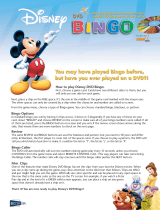Page is loading ...

GUIDE
LER 5994
For a dealer near you, call:
(847) 573-8400 (U.S. & Int’l)
(800) 222-3909 (U.S. & Canada)
+44 (0)1553 762276 (U.K. & Europe)
© Learning Resources, Inc., Vernon Hills, IL (U.S.A.)
Learning Resources Ltd., King’s Lynn, Norfolk (U.K.)
Please retain our address for future reference.
Made in China. LRM5994-GUD

Players practice identifying different animals while playing bingo and
having fun! Learning different animals and their names will help increase
vocabulary and communication skills. Common animals were chosen for
this game: dog, cat, cow, chicken, bird, pig, elephant, fox, fish, sheep, goat,
donkey, duck, mouse, rabbit, and horse.
Two levels of game play are included. Photographs of each animal are
shown on Side 1 of the bingo card. Vocabulary words describing each
animal are listed on Side 2 of the bingo card.
Contents:
• 4 Bingo Cards • Spinner • 36 Game markers
Object of the Game:
Be the first player to cover three spaces in a row, a column, or diagonally
with the game markers.
Note: This game is best played if the spinner is an adult or student who
can read.
Playing the Game:
Each player selects a bingo card and uses Side 1. Players may fill their free
space with a game marker. Designate one person to be the spinner. The
designated person spins the spinner and reads the animal that the arrow
stops on. The spinner should also record what was spun to check the
winner’s card at the end of the game. All players check their card to find an
image that matches the word that was called. If a player has an image of
the animal called, he or she should cover it with a game marker. Players
may cover one space per turn. The same person spins again and game play
continues until one player covers three spaces in a row, a column, or
diagonally. The winner’s game card should be checked with what was called
to make sure the images covered match what was called.
When playing with Side 2 of the bingo card, players will cover up the
vocabulary word that matches the word spun.
Alternative Ways to Practice Vocabulary:
Make a word wall. Introduce the different words to the class and spell them
together. Encourage the students to use these words in their writing
throughout the week.
Play an acting game using the new animal words. Have each student stand
up by their desk. Call out an animal word on the spinner and have the
students act like that animal, either by making the sound that it makes or
acting like the animal. For example, if the teacher calls out, “cow”, then the
students should all say “moo.” This is a fun and interactive way for students
to lear
n dif
fer
ent animals and their sounds.
/
















